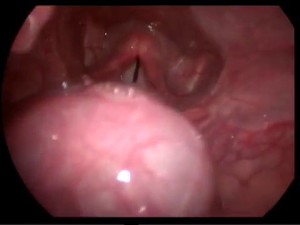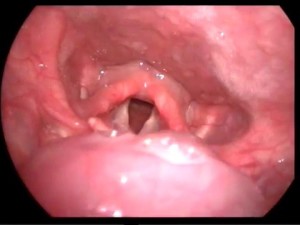Sonal S. Khatavkar, MBBS, DA, DNB1, Sharad B. Bhalekar, MBBS, MS2, Nagendra Sai, MBBS3, Tewari Divya, MBBS3
1Associate Professor, 3PG Resident
Department of Anesthesiology, Dr. D.Y. Patil Medical College, Hospital & Research Centre, Pimpri, Sant Tukaram Nagar, Pune, Maharashtra 411018, (India)
2Associate Professor, Department of ENT, Dr. D. Y. Patil Medical College. Dr. D.Y. Patil Vidyanagar, Sector 5, Nerul, Navi Mumbai – 400706 Maharashtra (India)
Correspondence: Dr Sonal S. Khatavkar, MBBS, DA, DNB Anesthesiology, Associate Professor, Dr. D.Y. Patil Medical College, Hospital & Research Centre, Pimpri, Sant Tukaram Nagar, Pune, Maharashtra 411018, (India); Cell: +91 9820434472; Email: drsonalkhatavkar@yahoo.co.in
ABSTRACT
Lingual thyroid (LT) gland is a rare clinical entity which occurs due to failure of thyroid gland to descend to its normal cervical location during embryogenesis. Maternal antithyroid immunoglobulins may impair gland descent during early fetal life and cause lingual thyroid. This condition is associated with increase in levels of thyroid stimulating harmone (TSH). As the ectopic thyroid grows, requirement of thyroid harmone increases thus many patients with ectopic thyroid are associated with hypothyroid and require treatment.
Ectopic thyroid gland is located at base of tongue and can present with dysphagia, dysphonia, upper airway obstruction and hemorrhage. Oropharyngeal mass can lead to difficult intubation and failure of ventilation. Evaluation of airway and indirect laryngoscopy may hint towards need of fiberoptic intubation. We present a case of 11 years old child of LT for appendectomy under general anesthesia.
Key words: Lingual thyroid; Congenital Abnormalities; Thyroid Dysgenesis; Airway Management; Intubation; Difficult airway; Appendecetomy; Ectopic thyroid; Levothyroxin sodium
Citation: Khatavkar SS, Bhalekar SB, Sai N, Divya T. Lingual thyroid as an anesthetic challenge. Anaesth Pain & Intensive Care 2016;20(1):59-61.
INTRODUCTION
Lingual thyroid (LT) is a rare clinical entity due to failure of descent of thyroid gland in the course of embryogenesis. 90 % of ectopic thyroids are formed at the base of tongue. LT is a rare developmental anomaly originating from aberrant embryogenesis during passage of thyroid gland through the neck resulting in lingual (at tongue base), sublingual (below tongue), prelaryngeal (in front of larynx) or substernal or retrosternal (in mediastinum) thyroid. Dual ectopic thyroid has been described.1 It originate from epithelial tissue of non-obliterated thyroglossal duct. Prevalence is 1 in 100,000 to 1 in 300,000 and female to male ratio is 4:1.2
Clinical presentation may vary from mild dysphagia, dysphonia to severe respiratory obstruction.
Its position and size may cause obstruction of laryngeal pathway leading to ventilation and intubation difficulties with a potential dramatic risk of hemorrhage during attempts of intubation. Managing a patient with difficult airway is almost the most challenging and stressful tasks in anesthesia..3 The ability to provide adequate ventilation and to perform tracheal intubation is associated with major morbidity and mortality.4 We report successful management of a case of LT for appendectomy under general anesthesia with an anticipated difficult airway, keeping full preparation and every equipment ready.
CASE REPORT
An 11 years old male child presented with pain abdomen, vomiting and fever for 2 days. He lso complained of a reddish swelling on tongue causing difficulty during eating and deglutition. His parents told that the swelling on tongue appeared one year back so they referred to pediatrician who investigated and labeled it as lingual swelling. Patient’s thyroid function tests (TFTs) were done, in which TSH was increased. USG neck revealed absence of thyroid gland in neck.
A thyroid scan with technetium TC-99m revealed a marked isotope uptake in the area of tongue but no uptake in neck. Tab. levothyroxine sodium anhydrous BP was started at 5 µg/kg/day regularly and TFTs were controlled.
Patient was asymptomatic in these years. He was an 11 yrs old male child weighing 25 kg, conscious and co-operative. His pulse rate was 80/min and blood pressure 110/76 mmHg. Systemic examination was normal. Oral cavity examination revealed a reddish and granular swelling of 2.5 cm x 2.5cm on the tongue (Figure 1). All routine investigations including chest x-ray were normal. As a swelling on tongue could pose difficulty in intubation we did indirect laryngoscopy (IDL), which revealed a swelling on the tongue but bilaterally mobile cords (Figure 2).
Figure 1: The lingual thyroid at the base of tongue

Figure 2: The mass visualized by indirect laryngoscopy

Patient was accepted as ASA grade II, with consent for emergency tracheostomy if required. All routine monitors were attached.
Inj glycopyrrolate 0.4 mg/kg and ondansetron 0.1 mg/kg were given as premedication, anesthesia was induced with sevoflurane and inj propofol 2-2.5 mg/kg. Lungs were gently inflated with oxygen to check the ability to ventilate the patient. Then inj suxamethonium 1.25 mg/kg was given and a gauze piece was placed over lingual thyroid to avoid trauma. Quick gentle laryngoscopy was done and cords visualized, a cuffed endotracheal tube No. 6 was inserted, air entry on both sides was confirmed. EtCO2 was 25 mmHg. Midazolam 0.03 mg/kg and fentanyl 20 µg given after intubation. Maintenance of anesthesia was done with sevoflurane 1-1.5% in O2 40% and N2O 60%. Inj vecuronium 2.5 mg was used as a relaxant and dexamethasone given to prevent edema of airway. Intraoperative hemodynamic parameters remained stable.
At the end of surgery patient was reversed with inj neostigmine 1.25 mg and inj glycopyrrolate 0.2 mg and the patient extubated uneventfully. Postoperatively, no respiratory obstruction was there, patient was observed in recovery and shifted after 2 hours.
DISCUSSION
Ectopic thyroid is a rare embryological aberration which occurs in path of migration of the thyroid resulting in lingual (at tongue base), sublingual (below tongue), prelaryngeal (in front of larynx) or substernal or retrosternal (in mediastinum) thyroid. Dual ectopic thyroid has been described.5 Embryonic development begins after 24 days of fertilization in floor of primitive hypopharynx from median endodermal thickening, then the primitive gland descends closely related to hyoid and laryngeal cartilages. Hickman recorded the first case of lingual thyroid in 1869.6
Any functioning thyroid tissue found outside of the normal thyroid location is termed as ectopic thyroid tissue. Although it is usually found along the normal path of development, ectopic tissue is also noted in the mediastinum, heart, esophagus and diaphragm. LT is the result of failure of descent of the thyroid gland from the foramen cecum of the tongue. The reasons for the failure to descent are unknown. LT pathogenesis is unclear but some authors have postulated that maternal antithyroid immunoglobulins may have impaired gland descent during early fetal life.
LT is commonly seen at any age group but more during childhood, adolescence, around menopause. This probably occurs when demand for thyroid hormone increases causing increase in circulating TSH levels with growth of ectopic thyroid tissue.7 About 33-62% patients are hypothyroid with increased level of TSH.8
In 50% of the population the distal end of the thyroglossal duct persists as the pyramidal lobe extending superiorly from the isthmus and may be attached to the hyoid bone by fibrous tissue. This is an infrequent congenital abnormality and also generally occurs along the path of the thyroglossal duct during the developmental period. LT glandular tissue is the most common, situated at the base of the tongue just behind the foramen cecum. Intralingual thyroid masses have been reported to occur in approximately 10% of autopsies. Incomplete descent results in a sublingual thyroid gland position at or just inferior to the hyoid bone.
Clinical presentation may be variable; most patients are asymptomatic. Symptoms are related to growth of thyroid tissue causing dysphagia, dysphonia with stomatolalia, bleeding or dyspnea.9,10 The clinical findings of LT could be classified in two groups according to the appearance of symptoms: infants and young children, whose lingual thyroid is detected via routine screening may suffer from failure to thrive and mental retardation, or even severe respiratory distress, resulting in a medical emergency. Other cases may present with onset of slowly progressing dysphagia, and symptoms of or pharyngeal obstruction before or during puberty. This occurs as a response to the increased demand of thyroid hormone in these hypermetabolic states. Similar response is also encountered during other metabolic stress conditions like pregnancy, infections, trauma, menopause, etc. LT usually present itself as a midline nodular mass in the base of the tongue. The surface of the lesion is usually smooth and vascularity can be seen, as was the case in our patient. Thorough head and neck examination with special attention to the base of tongue is mandatory. Investigations include thyroid function tests (often demonstrate normal gland functions). Technetium scanning confirms the presence of ectopic thyroid gland at the base of the tongue. There was no normal thyroid gland on scintigraphic and radiological examinations in our case. Thyroid scan with technetium Tc-99m sodium, CT or MRI can be useful diagnostic tools. Iin 75% patients of ectopic thyroid, ectopic gland is only the functional gland.11 Histologically on FNAC, LT resembles normal thyroid tissue.
This paper reports the case of an expected difficult airway due to a symptomatic mass in the oropharynx. The enlarged LT has been described as a cause of difficult intubation during induction of anesthesia, especially for bleeding.12 Our approach to the airway was based on two targets. The first was to keep spontaneous breathing: we avoided the use of sedative drugs that could cause apnea and posterior displacement of the soft palate or base of the tongue. In addition, no attempt to insert guedel airway, LMA, or fast track was made, which could injure the fragile tissue leading to bleeding with a fatal outcome.
Fiberoptic nasal intubation is the choice of intubation but we didn’t have this facility. Before intubation we did indirect laryngoscopy with 70 degree scope and vocal cords were visualized.
In view of difficult airway we induced anesthesia with propofol and sevoflurane and gentle laryngoscopy was done with gauze piece covering LT. Intubation was done with very gently. During recovery gentle and careful suctioning was done and patient extubated when full awake. No postextubation airway obstruction was observed.
Conflict of interest: None declared by the authors
REFERENCES
- Ulug T, Ulubil SA, Alagol F. Dual ectopic thyroid: report of a case. J Laryngol Otol. 2003 Jul;117(7):574-6. [PubMed]
- Douglas PS, Baker AW. Lingual thyroid. Br J Oral Maxillofac Surg. 1994 Apr;32(2):123-4. [PubMed]
- Kheterpal S, Martin L, Shanks AM, Tremper KK. Premediction and outcomes of impossible mask ventilation: a review of 50,000 anesthetics. 2009 Apr;110:891-7. [PubMed] [Free full text]
- Caplan RA, Posner KL, Ward RJ, Cheney FW. Adverse respiratory events in anaesthesia: a closed claims analysis. Anesthesiology. 1990 May;72(5):828-33. [PubMed] [Free full text]
- Huang TS, Chen HY. Dual thyroid ectopia with a normally located pretracheal thyroid gland: case report and literature review. Head Neck. 2007 Sep;29(9):885-8. [PubMed]
- Hickman W: Congenital tumor of the base of tongue, pressing down the epiglottis on the larynx and causing the death by suffocation sixteen hours after birth. Trans Pathology Soc London,1869,20:160-3
- Kumar R, Sharma S, Marwah A, Moorthy D, Dhanwal D, Malhotra A. Ectopic goiter masquerading as submandibular gland swelling: a case report and review of the literature. Clin Nucl Med. 2001 Apr;26(4):306-9. [PubMed]
- Yoon JS, Won KC, Cho IH, Lee JT, Lee HW. Clinical characteristics of ectopic thyroid in Korea. Thyroid. 2007 Nov;17(11):1117-21. [PubMed]
- Gallo A, Leonetti F, Torri E, Manciocco V, Simonelli M, DeVincentiis M. Ectopic lingual thyroid as unusual cause of severe dysphagia. Dysphagia. 2001 Summer;16(3):220-3. [PubMed]
- Mussak EN, KackerA. Surgical and medical management of midline ectopic thyroid. Otolaryngol Head Neck Surg. 2007 Jun;136(6):870-2. [PubMed]
- Baik SH, Choi JH, Lee HM. Dual ectopic thyroid. Eur Arch Otorhinolaryngol. 2002 Feb;259(2):105-7. [PubMed]
- Hafidh MA, Sheahan P, Khan NA, Colreavy M, Timon C. Role of CO2 laser in the management of obstructive ectopic lingual thyroids. J Laryngol Otol. 2004 Oct;118(10):807-9. [PubMed]




 Facebook
Facebook Twitter
Twitter GooglePlus
GooglePlus Youtube
Youtube